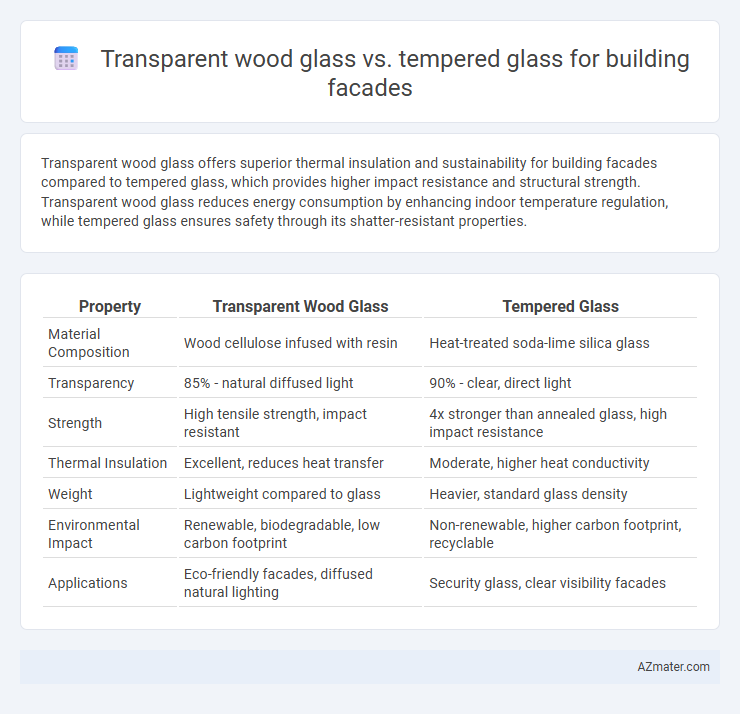Transparent wood glass offers superior thermal insulation and sustainability for building facades compared to tempered glass, which provides higher impact resistance and structural strength. Transparent wood glass reduces energy consumption by enhancing indoor temperature regulation, while tempered glass ensures safety through its shatter-resistant properties.
Table of Comparison
| Property | Transparent Wood Glass | Tempered Glass |
|---|---|---|
| Material Composition | Wood cellulose infused with resin | Heat-treated soda-lime silica glass |
| Transparency | 85% - natural diffused light | 90% - clear, direct light |
| Strength | High tensile strength, impact resistant | 4x stronger than annealed glass, high impact resistance |
| Thermal Insulation | Excellent, reduces heat transfer | Moderate, higher heat conductivity |
| Weight | Lightweight compared to glass | Heavier, standard glass density |
| Environmental Impact | Renewable, biodegradable, low carbon footprint | Non-renewable, higher carbon footprint, recyclable |
| Applications | Eco-friendly facades, diffused natural lighting | Security glass, clear visibility facades |
Introduction to Building Façade Materials
Transparent wood glass offers a sustainable and energy-efficient alternative to traditional tempered glass for building facades, combining natural aesthetics with high insulation properties. Tempered glass remains widely favored for its superior strength, safety, and clarity, making it ideal for withstanding extreme weather and impact. Recent advancements highlight transparent wood glass's potential to reduce carbon footprint while maintaining transparency and durability in modern architectural designs.
Overview of Tempered Glass
Tempered glass is a type of safety glass processed by controlled thermal or chemical treatments to increase its strength compared to normal glass. It shatters into small, blunt pieces rather than sharp shards, reducing the risk of injury in building facade applications. Commonly used in skyscrapers and modern architecture, tempered glass provides enhanced durability, impact resistance, and thermal stability.
What is Transparent Wood Glass?
Transparent wood glass, an innovative building material derived from natural wood, is chemically treated to remove lignin and infused with transparent polymers, resulting in a strong, lightweight, and highly insulating facade option. Unlike traditional tempered glass, it offers better thermal insulation, optical clarity, and sustainability due to its renewable source and reduced energy consumption in production. This material combines the mechanical strength of wood fibers with transparency, enabling energy-efficient, eco-friendly building facades that enhance natural lighting while reducing heat transfer.
Thermal Insulation Properties Compared
Transparent wood glass offers superior thermal insulation compared to tempered glass due to its natural lignin and cellulose structure, which reduces heat transfer while maintaining high transparency. Tempered glass, while stronger and more impact-resistant, has higher thermal conductivity, leading to greater heat loss or gain in building facades. Incorporating transparent wood glass in facades can significantly enhance energy efficiency by minimizing HVAC loads and improving indoor comfort.
Strength and Durability Analysis
Transparent wood glass exhibits enhanced impact resistance and superior tensile strength due to its cellulose nanofiber reinforcement, making it a promising alternative to traditional tempered glass in building facades. Tempered glass offers exceptional hardness and high resistance to thermal stress but is prone to catastrophic failure upon breakage, whereas transparent wood provides controlled fracture behavior with higher toughness. Durability tests reveal that transparent wood maintains structural integrity under prolonged UV exposure and humidity better than tempered glass, highlighting its suitability for long-term facade applications.
Light Transmission and Aesthetics
Transparent wood glass offers superior light diffusion, allowing natural light to penetrate while reducing glare, creating a warm and uniform illumination ideal for building facades. Tempered glass provides higher clarity and maximum transparency, delivering crisp views and a sleek, modern aesthetic favored in contemporary architecture. The choice between transparent wood glass and tempered glass depends on desired light quality and facade appearance, balancing natural light diffusion with visual sharpness.
Environmental Impact and Sustainability
Transparent wood glass offers significant environmental benefits compared to tempered glass, as it is derived from renewable resources and has a lower carbon footprint due to its bio-based composition and energy-efficient manufacturing process. This material enhances building sustainability by providing superior thermal insulation, reducing energy consumption for heating and cooling, and promoting the use of biodegradable and recyclable components. In contrast, tempered glass, while durable and strong, requires high-energy production and recycling processes that contribute to higher greenhouse gas emissions and greater environmental impact.
Cost Comparison and Market Availability
Transparent wood glass generally offers better cost-efficiency compared to tempered glass, with production costs ranging from $15 to $25 per square foot versus tempered glass's $20 to $40 per square foot due to advanced manufacturing processes and raw material expenses. Market availability of tempered glass is significantly higher, as it is widely produced and distributed globally for building facades, while transparent wood glass remains a niche product, primarily available through specialized manufacturers and limited pilot projects. The growing demand for sustainable materials is expected to gradually increase transparent wood glass availability, potentially affecting future cost dynamics.
Installation and Maintenance Considerations
Transparent wood glass offers lighter weight and easier cutting during installation compared to tempered glass, reducing labor costs and time on building facades. Maintenance of transparent wood glass involves periodic cleaning and protection from UV exposure to preserve clarity, while tempered glass requires routine inspections for cracks and damage due to its brittleness under impact. Choosing transparent wood glass can result in simplified installation and tailored maintenance protocols, enhancing overall facade performance and longevity.
Future Prospects for Façade Applications
Transparent wood glass offers promising future prospects for building facades due to its superior thermal insulation, lightweight nature, and sustainability compared to tempered glass. Advancements in transparent wood technology enhance its durability and optical clarity, making it a strong contender for energy-efficient and eco-friendly facades. The integration of transparent wood can significantly reduce building energy consumption while maintaining structural integrity and aesthetic appeal.

Infographic: Transparent wood glass vs Tempered glass for Building façade
 azmater.com
azmater.com